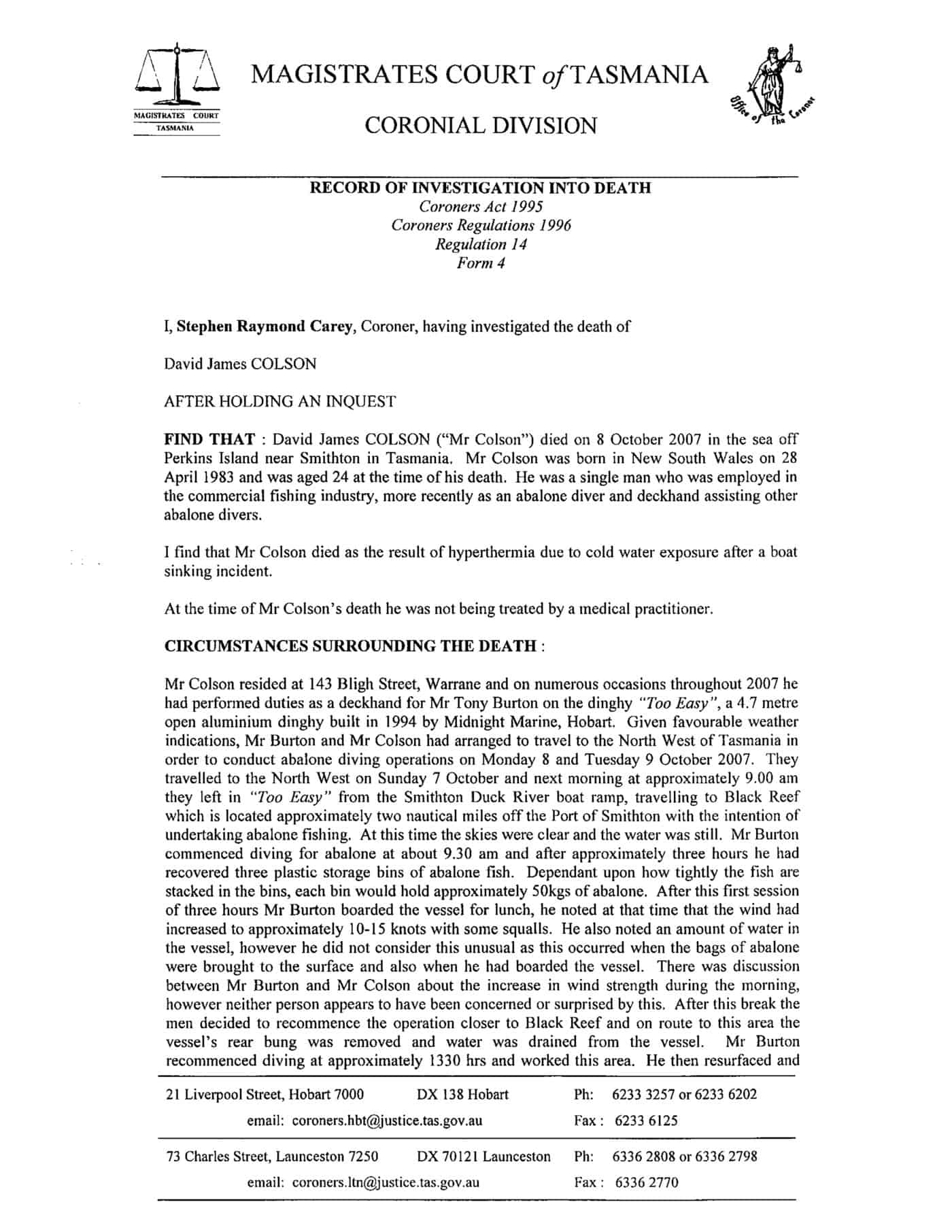On 11 January 2010, the Tasmanian Workplace Relations Minister, Lisa Singh, announced a new safety focus on the abalone industry following the findings of a coronial inquest into the death of David Colson in 2007.
There are several interesting elements to the Minister’s decision. Firstly and, perhaps, most importantly, the decision shows the significant role that Coroners in Australia play in improving workplace safety. For legislative change, it is difficult to see any more effective political motivator.
 Also, the Coroner can express opinions based on evidence in a way that few other courts do. The findings are not yet publicly available.
Also, the Coroner can express opinions based on evidence in a way that few other courts do. The findings are not yet publicly available.
The responses by the abalone fishing industry representatives are noteworthy for their familiarity to other industry associations.
In the Mercury newspaper the CEO of the Abalone Council, Dean Lisson, said:
“Commercial fishing as a money-generating activity requires risk-taking on a daily basis and those risks have to be weighed up by each individual operator… There is a risk/reward trade-off and that’s just the nature of the game.”
In OHS and risk management terms, Lisson’s comments are similar to many other established industry representatives from on-fishing sectors. They all seem that their industry is a special case when it comes to working safely but the obligations are the same in all industries and it is only the industry culture that varies.
Greg Woodham, from the Tasmanian Abalone Council, in a separate media report believes the industry has performed pretty well:
“I think, you know, we’ve been unfairly treated there in some respects… We do take on board that we could improve our work practices, but it is a tough environment that we work in and I think generally the community understands that.”
In an audio interview Woodham mentions a code of conduct but may have meant the December 2002 Code of Practice. (He also says that the lack of “common sense” has contributed to incidents)
The Code of Practice contains a disclaimer on page 4 that SafetyAtWorkBlog has not seen in other OHS Codes, and may indicate the sensitivity of safety obligations in the industry. As well as providing the Tasmanian Abalone Council Ltd with an immunity from liability, it states
“Each diver is assumed in the context of this Standard [?] to be voluntarily performing activities for which he/she assumes all risks, consequences and potential”.
There seems to be similarities in the above, and audio, comments to those of farmers and other established businesses that operate on the industrial “frontiers” – independence, self-reliance, suspicion of new concepts and a disdain for government regulation or intervention.
One of the biggest barriers to safety improvements is an attitude that big rewards are enough to balance big risks, that an activity is “inherently dangerous” or that an industry operates in a tough environment. If that were so, the Australian mining industry would still be losing dozens of miners each year. In that industry risks have been reduced in the workplace and the minds of the employees. It is difficult to see why the Tasmanian abalone industry should be so different.

David Colson died of hypothermia, he did not drown.
Thank you for the correction
Terry
I read the coroner’s findings last week and it was difficult to read the details of the drowning. As there was a survivor, the circumstances were more detailed than I often get to read and were confronting.
As far as I know, the coroner’s quite strident criticisms of the regulators and the industry have received no coverage on the mainland – perhaps in the local papers of coastal towns.
The Tasmanian Workplace Relations Minisnter, Lisa Singh, has acted promptly on the coroner’s report but whether a revised Code of Practice is sufficient is unclear.
The incident and the findings have echoes throughout buisness operations and safety procedures – communication, working in isolation, PPE, working outdoors…….
Thanks for the link to the report, I will update the blog posting with it today.
Kevin
Kevin,
It is always a shame that the death of a worker is what is required to drive changes to oh&s regulation. I agree that a coroner’s report can be a powerful tool to help implement those changes, however the coroner’s recommendations are not legally binding on anyone and it is often public pressure after the coroner’s report that results in change. I have read the report which is now available at http://www.magistratescourt.tas.gov.au/decisions/coronial_findings/c/coulson,_david_james_-_2010_tascd_1
It appears that so many basic rules of marine safety were broken that the outcome was inevitable. The other major concern I have is that no particular agency seemed to be responsible for ensuring oh&s standards were met. Enforcement since the incident appears to be spotty and applied in an uneven manner.
The report indicates that tests carried out by MAST after the incident indicated that the boat was capable of carrying 1000 kg in still water? Was that 1000 kg of abalone or 1000 kg of total weight including outboard engines, fuel, workers, diving and emergency equipment and miscellaneous materials? My interpretation would be that that the 1000 kg is total weight of everything.
My final point goes to the COP that you referenced which deals with “surface supplied breathing apparatus” (SSBA) diving in the abalone industry. What kind of diving was being done on the day of the incident? SSBA, SCUBA or free, there didn’t seem to be any indication in the coroner’s report or any news reports that I was able to find.
Hopefully some positive actions come from this tragedy that will minimize the risk in what is a hazardous industry.